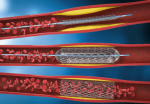In the first session of SOLACI-SOCIME 2022 on “Complex angioplasty guided by intravascular imaging”, Dr. Alejandro Diaz (MEX) reviewed the evidence on intravascular ultrasound (IVUS) in complex angioplasties. A meta-analysis indicated its use is associated with a significant decrease in the risk of death, acute myocardial infarction (AMI), and new target lesion revascularization (TLR) in...
Three-Year Outcomes after CTA with 2-Stent Technique Vs. Provisional Stenting for Complex Bifurcation Lesions
The prevalence of coronary lesions with bifurcation involvement is about 20% in patients undergoing coronary angiography (CTA). While provisional stenting is overall the most accepted technique, the 2018 myocardial revascularization guidelines recommend the 2-stent technique for complex bifurcation lesions, defined as side branch with lesion >5mm, distal reference diameter of the side branch ≥2.75, or...
Complicated Non-Stenotic Carotid Plaques: A Light in the Diagnosis of Cryptogenic Stroke?
Stroke is one of the leading causes of death and disability. It produces great morbidity by causing marked post-event cognitive impairment. Recurrence of an ischemic event may vary according to the cause of the stroke. Complicated non-stenotic carotid plaque (CCP) type VI (according to the American Heart Association [AHA] classification) has been described as an...
Using Biolimus-Coated Balloons for Treating Small-Vessel Disease Yields Promising Results
Drug-eluting balloons have demonstrated safety and effectiveness in the treatment of small-vessel coronary artery disease and in-stent restenosis. However, randomized studies were performed using paclitaxel. Several studies have shown that using biolimus, a semisynthetic analog of sirolimus, optimizes drug delivery in both stents and balloons. The aim of this randomized, multicenter study was to evaluate...
Revascularization Using DES in Infrapopliteal Disease: Meta-Analysis and Change of Paradigm?
Peripheral vascular disease (PVD) has been under-studied and under-recognized in comparison with ischemic heart disease and stroke, despite its well-known impact on quality of life and its associated morbidity and mortality. According to a systematic review, it was estimated that in 2015 about 238 million people globally had PVD. This number is on the rise....
DISCO RADIAL: Conventional or Distal Transradial Access?
Conventional transradial access (TRA) is already established as the access of choice for percutaneous coronary procedures, regardless of clinical presentation. This choice is based on multiple randomized studies and meta-analyses that have shown reduced bleeding at the puncture site, less vascular complications, and benefits on mortality (mainly in high-risk patients). The practicality of recovery allows...
Should We Start Using OCT in Myocardial Infarction with Non-Obstructive Lesions?
In ST elevation MI, the common assessment methodology continues to the angiography; however, we all know it has certain limitations, especially when it comes to intermediate lesions or coronary dissections. Using imaging, especially high resolution such as OCT, has been looked into by some studies, but never randomized studies. The EROSION III is a randomized...
IVUS-Guided Coronary Angioplasty: Promising Results at 3-Year Follow-Up
Intravascular ultrasound (IVUS) to guide drug-eluting stent (DES) implantation has been evaluated in several studies. Two randomized studies, IVUS-XPL (Impact of Intravascular Ultrasound Guidance on the Outcomes of Xience Prime Stents in Long Lesions) and ULTIMATE (Intravascular Ultrasound Guided Drug Eluting Stents Implantation in All-Comers Coronary Lesions), have shown fewer repeat revascularizations compared with angiography-guided...
OCT in STEMI Patients: Is It Safe to Prevent Stenting?
Percutaneous coronary intervention in patients with acute myocardial infarction (AMI) where the physiopathological mechanism is plaque erosion or non-atherosclerotic mechanisms (such as spontaneous coronary artery dissection) is not beneficial according to recent studies. The EROSION study (Effective Anti-Thrombotic Therapy Without Stenting: Intravascular Optical Coherence Tomography–Based Management in Plaque Erosion) has shown medical treatment with no...
ACC 2022 – EDIT-CMD
Roughly 40% of patients receiving a coronary angiography for stable angina (angina episodes twice a week despite medical treatment, lasting 3 months) do not present obstructive coronary artery disease (ANOCA). Between 60 to 90% is due to coronary vasomotor dysfunction (CVDys) which might be interpreted as vessel spasm or microvascular dysfunction. A recent publication from...









